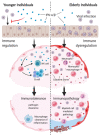Aging and Interferons: Impacts on Inflammation and Viral Disease Outcomes
- PMID: 33806810
- PMCID: PMC8004738
- DOI: 10.3390/cells10030708
Aging and Interferons: Impacts on Inflammation and Viral Disease Outcomes
Abstract
As highlighted by the COVID-19 global pandemic, elderly individuals comprise the majority of cases of severe viral infection outcomes and death. A combined inability to control viral replication and exacerbated inflammatory immune activation in elderly patients causes irreparable immune-mediated tissue pathology in response to infection. Key to these responses are type I, II, and III interferons (IFNs), which are involved in inducing an antiviral response, as well as controlling and suppressing inflammation and immunopathology. IFNs support monocyte/macrophage-stimulated immune responses that clear infection and promote their immunosuppressive functions that prevent excess inflammation and immune-mediated pathology. The timing and magnitude of IFN responses to infection are critical towards their immunoregulatory functions and ability to prevent immunopathology. Aging is associated with multiple defects in the ability of macrophages and dendritic cells to produce IFNs in response to viral infection, leading to a dysregulation of inflammatory immune responses. Understanding the implications of aging on IFN-regulated inflammation will give critical insights on how to treat and prevent severe infection in vulnerable individuals. In this review, we describe the causes of impaired IFN production in aging, and the evidence to suggest that these impairments impact the regulation of the innate and adaptive immune response to infection, thereby causing disease pathology.
Keywords: aging; immunopathology; inflammation; monocyte/macrophages; type I IFN; type II IFN; type III IFN.
Conflict of interest statement
The authors declare no conflict of interest.
Figures


References
-
- Lieberman N.A.P., Peddu V., Xie H., Shrestha L., Huang M.L., Mears M.C., Cajimat M.N., Bente D.A., Shi P.Y., Bovier F., et al. In vivo antiviral host transcriptional response to SARS-CoV-2 by viral load, sex, and age. PLoS Biol. 2020;18:e3000849. doi: 10.1371/journal.pbio.3000849. - DOI - PMC - PubMed
-
- Magleby R., Westblade L.F., Trzebucki A., Simon M.S., Rajan M., Park J., Goyal P., Safford M.M., Satlin M.J. Impact of Severe Acute Respiratory Syndrome Coronavirus 2 Viral Load on Risk of Intubation and Mortality Among Hospitalized Patients With Coronavirus Disease 2019. Clin. Infect. Dis. 2020:1–9. doi: 10.1093/cid/ciaa851. - DOI - PMC - PubMed
-
- To K.K.W.K.W., Hung I.F.N.F.N., Li I.W.S.W.S., Lee K.L., Koo C.K., Yan W.W., Liu R., Ho K.Y., Chu K.H., Watt C.L., et al. Delayed clearance of viral load and marked cytokine activation in severe cases of pandemic H1N1 2009 influenza virus infection. Clin. Infect. Dis. 2010;50:850–859. doi: 10.1086/650581. - DOI - PMC - PubMed
Publication types
MeSH terms
Substances
Grants and funding
LinkOut - more resources
Full Text Sources
Other Literature Sources
Medical
Research Materials

